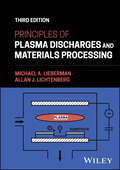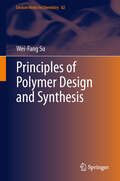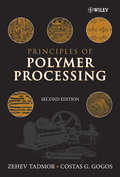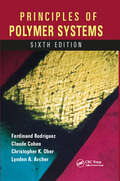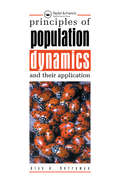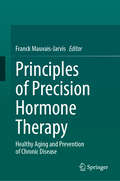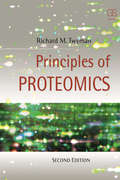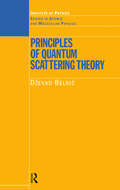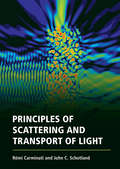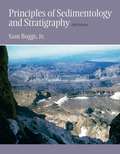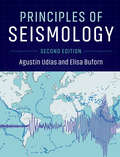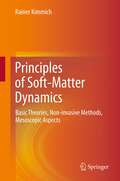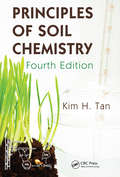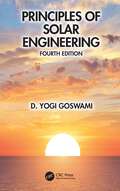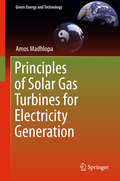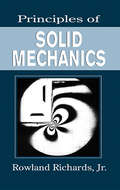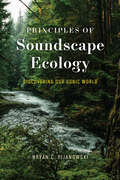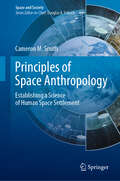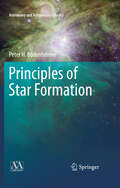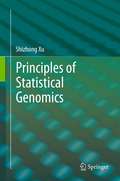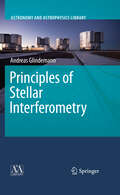- Table View
- List View
Principles of Plasma Discharges and Materials Processing
by Michael A. Lieberman Allan J. LichtenbergA new edition of this industry classic on the principles of plasma processing Plasma-based technology and materials processes have been central to the revolution of the last half-century in micro- and nano-electronics. From anisotropic plasma etching on microprocessors, memory, and analog chips, to plasma deposition for creating solar panels and flat-panel displays, plasma-based materials processes have reached huge areas of technology. As key technologies scale down in size from the nano- to the atomic level, further developments in plasma materials processing will only become more essential. Principles of Plasma Discharges and Materials Processing is the foundational introduction to the subject. It offers detailed information and procedures for designing plasma-based equipment and analyzing plasma-based processes, with an emphasis on the abiding fundamentals. Now fully updated to reflect the latest research and data, it promises to continue as an indispensable resource for graduate students and industry professionals in a myriad of technological fields. Readers of the third edition of Principles of Plasma Discharges and Materials Processing will also find: Extensive figures and tables to facilitate understanding A new chapter covering the recent development of processes involving high-pressure capacitive discharges New subsections on discharge and processing chemistry, physics, and diagnostics Principles of Plasma Discharges and Materials Processing is ideal for professionals and process engineers in the field of plasma-assisted materials processing with experience in the field of science or engineering. It is the premiere world-wide basic text for graduate courses in the field.
Principles of Plasma Physics for Engineers and Scientists
by Umran Inan Marek GołkowskiThis unified introduction provides the tools and techniques needed to analyze plasmas and connects plasma phenomena to other fields of study. Combining mathematical rigor with qualitative explanations, and linking theory to practice with example problems, this is a perfect textbook for senior undergraduate and graduate students taking one-semester introductory plasma physics courses. For the first time, material is presented in the context of unifying principles, illustrated using organizational charts, and structured in a successive progression from single particle motion, to kinetic theory and average values, through to collective phenomena of waves in plasma. This provides students with a stronger understanding of the topics covered, their interconnections, and when different types of plasma models are applicable. Furthermore, mathematical derivations are rigorous, yet concise, so physical understanding is not lost in lengthy mathematical treatments. Worked examples illustrate practical applications of theory and students can test their new knowledge with 90 end-of-chapter problems.
Principles of Polymer Chemistry
by A. RavveThis successful textbook undergoes a change of character in the third edition. Where earlier editions covered organic polymer chemistry, the third edition covers both physical and organic chemistry. Thus kinetics and thermodynamics of polymerization reactions are discussed. This edition is also distinct from all other polymer textbooks because of its coverage of such currently hot topics as photonic polymers, electricity conducting polymers, polymeric materials for immobilization of reagents and drug release, organic solar cells, organic light emitting diodes. This textbook contains review questions at the end of every chapter, references for further reading, and numerous examples of commercially important processes.
Principles of Polymer Design and Synthesis
by Wei-Fang SuHow can a scientist or engineer synthesize and utilize polymers to solve our daily problems? This introductory text, aimed at the advanced undergraduate or graduate student, provides future scientists and engineers with the fundamental knowledge of polymer design and synthesis to achieve specific properties required in everyday applications. In the first five chapters, this book discusses the properties and characterization of polymers, since designing a polymer initially requires us to understand the effects of chemical structure on physical and chemical characteristics. Six further chapters discuss the principles of polymerization reactions including step, radical chain, ionic chain, chain copolymerization, coordination and ring opening. Finally, material is also included on how commonly known polymers are synthesized in a laboratory and a factory. This book is suitable for a one semester course in polymer chemistry and does not demand prior knowledge of polymer science.
Principles of Polymer Processing
by Costas G. Gogos Zehev TadmorThoroughly revised edition of the classic text on polymer processingThe Second Edition brings the classic text on polymer processing thoroughly up to date with the latest fundamental developments in polymer processing, while retaining the critically acclaimed approach of the First Edition. Readers are provided with the complete panorama of polymer processing, starting with fundamental concepts through the latest current industry practices and future directions. All the chapters have been revised and updated, and four new chapters have been added to introduce the latest developments.Readers familiar with the First Edition will discover a host of new material, including:* Blend and alloy microstructuring* Twin screw-based melting and chaotic mixing mechanisms* Reactive processing* Devolatilization--theory, mechanisms, and industrial practice* Compounding--theory and industrial practice* The increasingly important role of computational fluid mechanics* A systematic approach to machine configuration designThe Second Edition expands on the unique approach that distinguishes it from comparative texts. Rather than focus on specific processing methods, the authors assert that polymers have a similar experience in any processing machine and that these experiences can be described by a set of elementary processing steps that prepare the polymer for any of the shaping methods. On the other hand, the authors do emphasize the unique features of particular polymer processing methods and machines, including the particular elementary step and shaping mechanisms and geometrical solutions.Replete with problem sets and a solutions manual for instructors, this textbook is recommended for undergraduate and graduate students in chemical engineering and polymer and materials engineering and science. It will also prove invaluable for industry professionals as a fundamental polymer processing analysis and synthesis reference.
Principles of Polymer Systems
by Ferdinand Rodriguez Claude Cohen Christopher K. Ober Lynden ArcherA classic text in the field of chemical engineering, this revised sixth edition offers a comprehensive exploration of polymers at a level geared toward upper-level undergraduates and beginning graduate students. It contains more theoretical background for some of the fundamental concepts pertaining to polymer structure and behavior, while also providing an up-to-date discussion of the latest developments in polymerization systems. New problems have been added to several of the chapters, and a solutions manual is available upon qualifying course adoption.
Principles of Population Dynamics and Their Application
by Alan A. BerrymanThis book provides an introduction to population dynamics, exploring rules that govern change in any dynamic system and applying these general principles to populations of living organisms. Principles of Population Dynamics and their Application is aimed at applied ecologists, resource managers. and pest managers. It is also aimed at undergraduate students taking courses in forestry, fisheries, widlife and pest management.
Principles of Precision Hormone Therapy: Healthy Aging and Prevention of Chronic Disease
by Franck Mauvais-JarvisHormones—such as estrogens, testosterone, thyroid hormones, and growth hormone—are essential for metabolic homeostasis in all cells. However, their levels decline with age, contributing to aging and chronic disease. Proper hormone therapy can help delay the onset of age-related diseases, yet there is currently no authoritative, up-to-date resource on precision hormone optimization for healthy aging. Current standard of care textbooks rely on outdated concepts, while books aimed at non-specialist clinicians and patients are often written by non-experts and lack a solid scientific foundation. This book bridges that gap by presenting cutting-edge scientific data and insights from leading academic and private practice experts on the role of hormone optimization in healthy aging. It dispels common misconceptions about hormone therapy risks and highlights the proven benefits of precision hormone treatments. Drawing on both scientific evidence and clinical experience, it explores the distinctions between synthetic hormones and bioidentical, physiological hormones. Designed to challenge conventional thinking, this book aims to inspire discussion and further research among scientists and healthcare practitioners. It is an essential resource for basic and clinical researchers seeking translational knowledge on hormone therapy, as well as clinicians looking to integrate hormone optimization into their practice.
Principles of Proteomics
by Richard Twyman Ph.D Cfe George A.Principles of Proteomics, Second Edition, provides a concise and user-friendly introduction to the diverse technologies used for the large-scale analysis of proteins, as well as their applications, and their impact in areas such as drug discovery, agriculture, and the fight against disease. Proteomics is a fast-advancing field in which researchers seek to capture all the proteins in the cell and characterize them in ever more detail. Principles of Proteomics has been fully updated to reflect the most recent developments in the field without losing its focus on the underlying principles. With worked examples, case studies profiling both established and emerging technologies, and further reading lists for each chapter, Principles of Proteomics is an ideal introduction for students, researchers and those working in the industry.
Principles of Quantum Scattering Theory (Series in Atomic Molecular Physics)
by Dzevad BelkicScattering is one of the most powerful methods used to study the structure of matter, and many of the most important breakthroughs in physics have been made by means of scattering. Nearly a century has passed since the first investigations in this field, and the work undertaken since then has resulted in a rich literature encompassing both experimental and theoretical results. In scattering, one customarily studies collisions among nuclear, sub-nuclear, atomic or molecular particles, and as these are intrinsically quantum systems, it is logical that quantum mechanics is used as the basis for modern scattering theory. In Principles of Quantum Scattering Theory, the author judiciously combines physical intuition and mathematical rigour to present various selected principles of quantum scattering theory. As always in physics, experiment should be used to ultimately validate physical and mathematical modelling, and the author presents a number of exemplary illustrations, comparing theoretical and experimental cross sections in a selection of major inelastic ion-atom collisions at high non-relativistic energies. Quantum scattering theory, one of the most beautiful theories in physics, is also very rich in mathematics. Principles of Quantum Scattering Theory is intended primarily for graduate physics students, but also for non-specialist physicists for whom the clarity of exposition should aid comprehension of these mathematical complexities.
Principles of Research Methodology and Ethics in Pharmaceutical Sciences: An Application Guide for Students and Researchers (ISSN)
by Vikas Anand Saharan Hitesh Kulhari Hemant JadhavPharmaceutical researchers are constantly looking for drug products, drug delivery systems and devices for improving the health of society. A scientific and systematic search for new knowledge requires a thorough understanding of research methods and hypothesis design. This volume presents pharmaceutical research through theoretical concepts, methodologies and ethical issues. It fulfils publication ethics course work requirements for students. Chapters have been designed to cater for the curriculum requirements of universities globally. This serves as a guide on how to apply concepts in designing experiments and transforming laboratory research into actual practice.Features: · Complete coverage of research methodology courses for graduate and postgraduate students globally.· Step-by-step assistance in writing technical reports, projects, protocols, theses and dissertations.· Experimental designing in pharmaceutical formulation development and preclinical research designs.· Ethics in using animals in preclinical research and humans in clinical research.· Publication ethics, best practices and guidelines for ensuring ethical writing.· Hypothetical and real-world case studies on ethical issues and measures for prevention and control.
Principles of Scattering and Transport of Light
by Rémi Carminati John C. SchotlandLight scattering is one of the most well-studied phenomena in nature. It occupies a central place in optical physics, and plays a key role in multiple fields of science and engineering. This volume presents a comprehensive introduction to the subject. For the first time, the authors bring together in a self-contained and systematic manner, the physical concepts and mathematical tools that are used in the modern theory of light scattering and transport, presenting them in a clear, accessible style. The power of these tools is demonstrated by a framework that links various aspects of the subject: scattering theory to radiative transport, radiative transport to diffusion, and field correlations to the statistics of speckle patterns. For graduate students and researchers in optical physics and optical engineering, this book is an invaluable resource on the interaction of light with complex media and the theory of light scattering in disordered and complex systems.
Principles of Sedimentology and Stratigraphy (Fifth Edition)
by Sam BoggsThis concise treatment of the fundamental principles of sedimentology and stratigraphy highlights the important physical, chemical, biological, and stratigraphic characteristics of sedimentary rocks. It emphasizes the ways in which the study of sedimentary rocks is used to interpret depositional environments, changes in ancient sea level, and other intriguing aspects of Earth's history.
Principles of Seismology
by Elisa Buforn Agustín UdíasThe second edition of Principles of Seismology has been extensively revised and updated to present a modern approach to observation seismology and the theory behind digital seismograms. It includes: a new chapter on Earthquakes, Earth's structure and dynamics; a considerably revised chapter on instrumentation, with new material on processing of modern digital seismograms and a list of website hosting data and seismological software; and 100 end-of-chapter problems. The fundamental physical concepts on which seismic theory is based are explained in full detail with step-by-step development of the mathematical derivations, demonstrating the relationship between motions recorded in digital seismograms and the mechanics of deformable bodies. With chapter introductions and summaries, numerous examples, newly drafted illustrations and new color figures, and an updated bibliography and reference list, this intermediate-level textbook is designed to help students develop the skills to tackle real research problems.
Principles of Soft-Matter Dynamics
by Rainer KimmichPractical applications of soft-matter dynamics are of vital importance in material science, chemical engineering, biophysics and biotechnology, food processing, plastic industry, micro- and nano-system technology, and other technologies based on non-crystalline and non-glassy materials. Principles of Soft-Matter Dynamics. Basic Theories, Non-invasive Methods, Mesoscopic Aspects covers fundamental dynamic phenomena such as diffusion, relaxation, fluid dynamics, normal modes, order fluctuations, adsorption and wetting processes. It also elucidates the applications of the principles and of the methods referring to polymers, liquid crystals and other mesophases, membranes, amphiphilic systems, networks, and porous media including multiphase and multi-component materials, colloids, fine-particles, and emulsions. The book presents all formalisms, examines the basic concepts needed for applications of soft-matter science, and reviews non-invasive experimental techniques such as the multi-faceted realm of NMR methods, neutron and light quasi-elastic scattering, mechanical relaxation and dielectric broadband spectroscopy which are treated and compared on a common and consistent foundation. The standard concepts of dynamics in fluids, polymers, liquid crystals, colloids and adsorbates are comprehensively derived in a step-by-step manner. Principles and analogies common to diverse application fields are elucidated and theoretical and experimental aspects are supplemented by computational-physics considerations. Principles of Soft-Matter Dynamics. Basic Theories, Non-invasive Methods, Mesoscopic Aspects appeals to graduate and PhD students, post-docs, researchers, and industrial scientists alike.
Principles of Soil Chemistry (Books in Soils, Plants, and the Environment)
by Kim H. TanLearn the secrets of soil chemistry and its role in agriculture and the environment. Examine the fundamental laws of soil chemistry, how they affect dissolution, cation and anion exchange, and other reactions. Explore how water can form water-bridges and hydrogen bonding, the most common forces in adsorption, chelation, and more. Discover how elect
Principles of Solar Engineering
by D. Yogi GoswamiPrinciples of Solar Engineering, Fourth Edition addresses the need for solar resource assessment and highlights improvements and advancements involving photovoltaics and solar thermal technologies, grid power, and energy storage. With updates made to every chapter, this edition discusses new technologies in photovoltaics, such as organic, dye-sensitized, and perovskite solar cells, and the design of solar systems and power plants. It also features battery energy storage for distributed and bulk storage and electrical integration with the main solar systems. In addition, the book includes the latest advancements in concentrating solar power plants, such as supercritical CO2 cycle. Readers will benefit from discussions of the economics of the solar energy systems, which apply to all the systems covered in the subsequent chapters. Features: Discusses new forecasting models in solar radiation that are important to the economics and bankability of large solar energy systems, such as power plants. Includes expanded coverage of high temperature thermal storage for Concentrating Solar Thermal Power (CSP), including thermal energy transport using heat exchangers. Features a new chapter on solar seawater desalination. Includes new and additional end-of-chapter example problems and exercises. A Solutions Manual will be available for instructors. The book is intended for senior undergraduate and graduate engineering students taking Energy Engineering and Solar Energy courses.
Principles of Solar Gas Turbines for Electricity Generation (Green Energy and Technology)
by Amos MadhlopaThis is the first book dedicated to solar gas turbines, providing fundamental knowledge and state-of-the-art developments in the field. A gas turbine is a heat engine in which a mixture of fuel and air is burned in a chamber that is an integral part of the flow circuit of the working fluid. The burnt gas mixture expands and turns the turbine, which can be connected to a generator for electricity production. Solar gas turbines offer an important alternative to conventional gas turbines driven by non-renewable, polluting fossil fuels such as diesel or natural gas. The book provides a comprehensive overview of the topic as well as numerous illustrations.
Principles of Solid Mechanics (Mechanical and Aerospace Engineering Series)
by Jr., Rowland RichardsEvolving from more than 30 years of research and teaching experience, Principles of Solid Mechanics offers an in-depth treatment of the application of the full-range theory of deformable solids for analysis and design. Unlike other texts, it is not either a civil or mechanical engineering text, but both. It treats not only analysis but incorporates
Principles of Soundscape Ecology: Discovering Our Sonic World
by Bryan C. PijanowskiFrom a founding figure in the field, the definitive introduction to an exciting new science. What do the sounds of a chorus of tropical birds and frogs, a clap of thunder, and a cacophony of urban traffic have in common? They are all components of a soundscape, acoustic environments that have been identified by scientists as a combination of the biophony, geophony, and anthrophony, respectively, of all of Earth’s sound sources. As sound is a ubiquitous occurrence in nature, it is actively sensed by most animals and is an important way for them to understand how their environment is changing. For humans, environmental sound is a major factor in creating a psychological sense of place, and many forms of sonic expression by people embed knowledge and culture. In this book, soundscape ecology pioneer Bryan C. Pijanowski presents the definitive text for both students and practitioners who are seeking to engage with this thrilling new field. Principles of Soundscape Ecology clearly outlines soundscape ecology’s critical foundations, key concepts, methods, and applications. Fundamentals include concise and valuable descriptions of the physics of sound as well as a thorough elucidation of all sounds that occur on Earth. Pijanowski also presents a rich overview of the ecological, sociocultural, and technical theories that support this new science, illustrating the breadth of this amazingly transdisciplinary field. In methods, he describes the principles of data mining, signal processing, and mixed methods approaches used to study soundscapes in ecological, social, or socio-ecological contexts. The final section focuses on terrestrial, aquatic, urban, and music applications, demonstrating soundscape ecology’s utility in nearly all spaces.
Principles of Space Anthropology: Establishing a Science of Human Space Settlement (Space and Society)
by Cameron M. SmithThis book shows how anthropology can provide an innovative perspective on the human movement into space. It examines adaptation to space on timescales of generations, rather than merely months or years, and uses evolutionary adaptation as a guiding theme. Employing the lessons of evolutionary adaptation, Principles of Extraterrestrial Anthropology recommends evolutionarily-sound strategies of space settlement, covering genetics at the organismal and population levels. The author organizes the concept of cultural adaptation to environments beyond Earth according to observed patterns in human adaptation on Earth. He uses original artwork and tables to help convey complex information in a form accessible to undergraduate and graduate students. Though primarily written to engage students interested in space settlement and exploration, who will eventually build a full anthropology of space settlement, Principles of Extraterrestrial Anthropology is engaging to anthropologists across sub-disciplines, as well as scholars interested in the human dimensions of space exploration and settlement. Just as the term exobiology was invented only a few decades ago to shape the field of space life studies, exoanthropology is outlined to assist in the perpetuation of Earth life through human space settlement.
Principles of Star Formation
by Peter BodenheimerUnderstanding star formation is one of the key fields in present-day astrophysics. This book treats a wide variety of the physical processes involved, as well as the main observational discoveries, with key points being discussed in detail. The current star formation in our galaxy is emphasized, because the most detailed observations are available for this case. The book presents a comparison of the various scenarios for star formation, discusses the basic physics underlying each one, and follows in detail the history of a star from its initial state in the interstellar gas to its becoming a condensed object in equilibrium. Both theoretical and observational evidence to support the validity of the general evolutionary path are presented, and methods for comparing the two are emphasized. The author is a recognized expert in calculations of the evolution of protostars, the structure and evolution of disks, and stellar evolution in general. This book will be of value to graduate students in astronomy and astrophysics as well as to active researchers in the field.
Principles of Star Formation (Astronomy and Astrophysics Library)
by Peter BodenheimerUnderstanding star formation is one of the key fields in present-day astrophysics. This book treats a wide variety of the physical processes involved, as well as the main observational discoveries, with key points being discussed in detail. The current star formation in our galaxy is emphasized, because the most detailed observations are available for this case. The book presents a comparison of the various scenarios for star formation, discusses the basic physics underlying each one, and follows in detail the history of a star from its initial state in the interstellar gas to its becoming a condensed object in equilibrium. Both theoretical and observational evidence to support the validity of the general evolutionary path are presented, and methods for comparing the two are emphasized. The author is a recognized expert in calculations of the evolution of protostars, the structure and evolution of disks, and stellar evolution in general. This book will be of value to graduate students in astronomy and astrophysics as well as to active researchers in the field.
Principles of Statistical Genomics
by Shizhong XuStatistical genomics is a rapidly developing field, with more and more people involved in this area. However, a lack of synthetic reference books and textbooks in statistical genomics has become a major hurdle on the development of the field. Although many books have been published recently in bioinformatics, most of them emphasize DNA sequence analysis under a deterministic approach. Principles of Statistical Genomics synthesizes the state-of-the-art statistical methodologies (stochastic approaches) applied to genome study. It facilitates understanding of the statistical models and methods behind the major bioinformatics software packages, which will help researchers choose the optimal algorithm to analyze their data and better interpret the results of their analyses. Understanding existing statistical models and algorithms assists researchers to develop improved statistical methods to extract maximum information from their data. Resourceful and easy to use, Principles of Statistical Genomics is a comprehensive reference for researchers and graduate students studying statistical genomics.
Principles of Stellar Interferometry
by Andreas GlindemannThe imaging process in stellar interferometers is explained starting from first principles on wave propagation and diffraction. Wave propagation through turbulence is described in detail using Kolmogorov statistics. The impact of turbulence on the imaging process is discussed both for single telescopes and for interferometers. Correction methods (adaptive optics and fringe tracking) are presented including wavefront sensing/fringe sensing methods and closed loop operation. Instrumental techniques like beam combination and visibility measurements (modulus and phase) as well as Nulling and heterodyne interferometry are described. The book closes with examples of observing programmes linking the theory with individual astrophysical programmes.
